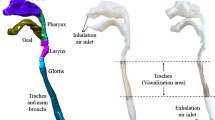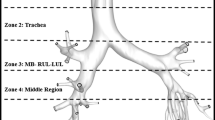Abstract
A simplified experimental nasal model was designed and an experimental setup was developed to facilitate both inspiratory and expiratory flow measurements. Particle image velocimetry (PIV) and resistance measurements were conducted. The purpose of this work was primarily to demonstrate a simple way of carrying out experiments for a replica human nose in order to validate numerical studies. The characteristic recirculatory patterns observed explicitly as a consequence of inspiration and expiration were investigated. The resistance study showed similar patterns of resistance for both experimental and numerical results for various flow rates. The PIV results showed that inspiratory and expiratory flows had characteristic flow patterns that can be distinguished based on their recirculatory flow patterns.









Similar content being viewed by others
References
Zubair, M., Abdullah, M. Z., & Ahmad, K. A. (2013). Hybrid mesh for nasal airflow studies. Computational and Mathematical Methods in Medicine, 1–7, 2013.
Riazuddin, V. N., Zubair, M., Abdullah, M. Z., Ismail, R., Shuaib, I. L., Suzina, A. H., & Ahmad, K. A. (2011). Numerical study of inspiratory and expiratory flow in a human nasal cavity. Journal of Medical and Biological Engineering, 31, 201–206.
Keyhani, K., Scherer, P. W., & Mozell, M. M. (1995). Numerical simulation of airflow in the human nasal cavity. Journal of Biomechanical Engineering, 117, 429–441.
Zubair, M., Riazuddin, V. N., Abdullah, M. Z., Ismail, R., Shuaib, I. L., Suzina, A. H., & Ahmad, K. A. (2013). Computational fluid dynamics study of the effect of posture on airflow characteristics inside the nasal cavity. Asian Biomed, 7, 835–840.
Wen, J., Inthavong, K., Tu, J., & Wang, S. (2008). Numerical simulations for detailed airflow dynamics in a human nasal cavity. Respiratory Physiology & Neurobiology, 161, 125–135.
Spence, C. J. T., Buchmann, N. A., Jermy, M. C., & Moore, S. M. (2011). Stereoscopic PIV measurements of flow in the nasal cavity with high flow therapy. Experiments in Fluids, 50, 1005–1017.
Hahn, I., Scherer, P. W., & Mozell, M. M. (1993). Velocity profiles measured for airflow through a large-scale model of the human nasal cavity. Journal of Applied Physiology, 75, 2273–2287.
Doorly, D., Taylor, D. J., Franke, P., & Schroter, R. C. (2008). Experimental investigation of nasal airflow. Part H: Journal of Engineering in Medicine, 222, 439–453.
Zubair, M., Abdullah, M. Z., Ismail, R., Shuaib, I. L., Suzina, A. H., & Ahmad, K. A. (2012). Review: Critical overview of limitations of CFD modeling of nasal airflow. Journal of Medical and Biological Engineering, 32, 77–84.
Menter, F. R. (1994). Two-equation eddy-viscosity turbulence models for engineering applications. AIAA journal, 32, 1598–1605.
Ishikawa, S., Nakayama, T., Watanabe, M., & Matsuzawa, T. (2006). Visualization of flow resistance in physiological nasal respiration: analysis of velocity and vorticities using numerical simulation. Archives of Otolaryngology: Head & Neck Surgery, 132, 1203–1209.
Zhao, K., Scherer, P. W., Hajiloo, S. A., & Dalton, P. (2004). Effect of anatomy on human nasal airflow and odorant transport patterns: implications for olfaction. Chemical Senses, 29, 365–379.
Zubair, M., Riazuddin, V. N., Abdullah, M. Z., Rushdan, I., Shuaib, I. L., & Ahmad, K. A. (2013). Computational fluid dynamics study of pull and plug flow boundary condition on nasal airflow. Biomedical Engineering: Applications, Basis and Communications, 25, 1350044–1350051.
Zhu, J. H., Lim, K. M., Gordon, B. R., Wang, D. Y., & Lee, H. P. (2014). Effects of anterior ethmoidectomy with and without antrotomy and uncinectomy on nasal and maxillary sinus airflows: a CFD study. Journal of Medical and Biological Engineering, 34, 144–149.
Acknowledgments
The authors acknowledge the support of the Geran Universiti Putra Malaysia and Fundamental Research Grant Scheme (FRGS).
Author information
Authors and Affiliations
Corresponding author
Rights and permissions
About this article
Cite this article
Zubair, M., Ahmad, K.A., Abdullah, M.Z. et al. Characteristic Airflow Patterns During Inspiration and Expiration: Experimental and Numerical Investigation. J. Med. Biol. Eng. 35, 387–394 (2015). https://doi.org/10.1007/s40846-015-0037-4
Received:
Accepted:
Published:
Issue Date:
DOI: https://doi.org/10.1007/s40846-015-0037-4




